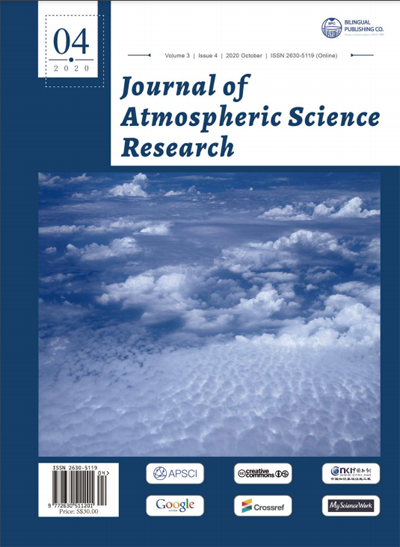-
882
-
400
-
361
-
359
-
342
Climatic Changes and Their Effect on Wildlife of District Dir Lower, Khyber Pakhtunkhwa, Pakistan
DOI:
https://doi.org/10.30564/jasr.v3i4.2275Abstract
Climatic changes and their impact are increasingly evident in Pakistan, especially in the mountainous regions. Mountain ecosystems are considered to be sensitive indicators of global warming; even slight variations in temperature can lead to significant shifts in local climate, which can, in turn, drastically affect the natural environment, subsequently altering people’s lifestyle and wildlife habitats. The targeted area for the present research was Lower Dir District, Pakistan. The study gathered the required information from primary and secondary sources. Secondary data on temperature and precipitation were obtained from various sources, i.e., local CBO, including WWF Pakistan. Based on information gathered on climate change and wildlife, a detailed questionnaire was designed. Results showed that no regular pattern of the increase was found in temperature from 2010 to 2018; the same was noticed in the rainfall decrease pattern. Results also showed that the leading causes behind climatic changes are an increase in greenhouse gases due to pollution by industries, vehicles, crushing plants, deforestation, and some natural phenomena such as floods. The study showed that more than 80% of the respondents agreed that climatic effects have a significant impact on wildlife, i.e., the existence of wildlife falls in danger due to climatic changes as it may lead to habitat change, making it difficult for the survival and adaptation of the wildlife. Hence, in consequence, it leads to migration, low growth rate, an increase in morbidity and mortality rate, and finally leading to the extinction of the species or population. It is concluded from the study that people are severely noticing the climatic change and its leading causes are greenhouse gases and deforestation. To control climatic changes and wildlife extinction, we need an appropriate policy for forest conservation, wildlife conservation, prevent hunting, industrial pollution control, vehicle pollution control, increase in plantation, awareness of policy for the control of climatic changes, etc.
Keywords:
Climate change; Wildlife; Temperature; Rainfall; Lower Dir; PakistanReferences
[1] Change, I.C. IPCC third assessment report. World Meteorological Organisation and UNEP http://www.ipcc, 2001.
[2] Joos, F., et al. Global warming feedbacks on terrestrial carbon uptake under the Intergovernmental Panel on Climate Change (IPCC) emission scenarios. Global Biogeochemical Cycles, 2001, 15(4): 891-907.
[3] McMichael AJ, Powles JW, Butler CD, Uauy R.Food, livestock production, energy, climate change, and health. The lancet, 2007, 370(9594): 1253-63.
[4] Rockström, J., et al. A safe operating space for humanity. nature, 2009, 461(7263): 472-475.
[5] Hasnat GT, Kabir MA, Hossain MA. Major environmental issues and problems of South Asia, Particularly Bangladesh. Handbook of environmental materials management. 2018: 1-40.
[6] Bazargan, A., A multidisciplinary introduction to desalination. Stylus Publishing, LLC, 2018.
[7] Sodhi, N.S., et al. A meta‐analysis of the impact of anthropogenic forest disturbance on Southeast Asia's biotas. Biotropica, 2009, 41(1): 103-109.
[8] Farooqi, A.B., A.H. Khan, H. Mir. Climate change perspective in Pakistan. Pakistan Journal of Meteorology, 2005, 2(3).
[9] Malmsheimer, R.W., et al. Managing forests because carbon matters: integrating energy, products, and land management policy. Journal of Forestry. 2011, 109(7S): S7-S50.
[10] da Silva Dias, M.A.F. Forest and Rainfall Interactions in the Amazon Basin. 2008.
[11] Kronstadt, K.A. Flooding in Pakistan: Overview and issues for congress. 2010: DIANE Publishing.
[12] Solomon S, Plattner GK, Knutti R, Friedlingstein P. Irreversible climate change due to carbon dioxide emissions. Proceedings of the national academy of sciences. 2009, 106(6): 1704-9.
[13] Sodhi NS, Brook BW, Bradshaw CJA. Causes and consequences of species extinctions. In: Levin SA, editor. The Princeton Guide to Ecology. Princeton, NJ:Princeton University Press: 2009: 514-20.
[14] Handmer J, Honda Y, Kundzewicz ZW, Arnell N, Benito G, Hatfield J, Mohamed IF, Peduzzi P, Wu S, Sherstyukov B, Takahashi K. Changes in impacts of climate extremes: human systems and ecosystems. InManaging the risks of extreme events and disasters to advance climate change adaptation special report of the intergovernmental panel on climate change. Intergovernmental Panel on Climate Change, 2012: 231-290.
[15] McComas K, Shanahan J. Telling stories about global climate change: Measuring the impact of narratives on issue cycles. Communication research, 1999, 26(1): 30-57.
[16] Posner EA, Weisbach D. Climate change justice. Princeton University Press, 2010.
[17] Sodhi NS, Posa MR, Lee TM, Bickford D, Koh LP, Brook BW. The state and conservation of Southeast Asian biodiversity. Biodiversity and Conservation, 2010, 19(2): 317-28.
[18] Pyšek P, Richardson DM. Invasive species, environmental change and management, and health. Annual review of environment and resources, 2010, 35.
[19] Sodhi NS, Brook BW, Bradshaw CJ. Causes and consequences of species extinctions. The Princeton guide to ecology, 2009, 1(1): 514-20.
[20] WWF Pakistan. Climate Change in the Northern Areas Pakistan: Impacts on glaciers, ecology and livelihoods. Pakistan, 2008.
[21] National Academy of Sciences (NAS) 2001. Climate Change Science: An Analysis of Some Key Questions. National Academies Press. 2001: 42.
[22] Change, A.D.G. Climate change science: An analysis of some key questions. National Academies Press, 2001.
[23] Whitfield, S.M., et al. Amphibian and reptile declines over 35 years at La Selva, Costa Rica. Proceedings of the National Academy of Sciences, 2007. 104(20): 8352-8356.
[24] Cusack C. Fish, Justice, and Society. Brill, 2018.
[25] Leadley P. Biodiversity scenarios: projections of 21st century change in biodiversity, and associated ecosystem services: a technical report for the global biodiversity outlook 3. UNEP/Earthprint, 2010.
[26] Goeppert A, Czaun M, Prakash GS, Olah GA. Air as the renewable carbon source of the future: an overview of CO 2 capture from the atmosphere. Energy & Environmental Science. 2012, 5(7): 7833-53.
[27] Potts SG, Biesmeijer JC, Kremen C, Neumann P, Schweiger O, Kunin WE. Global pollinator declines: trends, impacts and drivers. Trends in ecology & evolution. 2010, 25(6): 345-53.
Downloads
How to Cite
Issue
Article Type
License
Copyright © 2020 Author(s)

This is an open access article under the Creative Commons Attribution-NonCommercial 4.0 International (CC BY-NC 4.0) License.




 Asad Ullah
Asad Ullah






